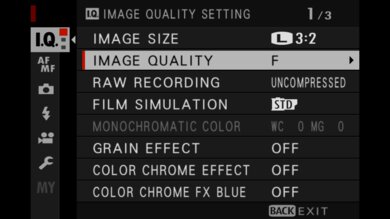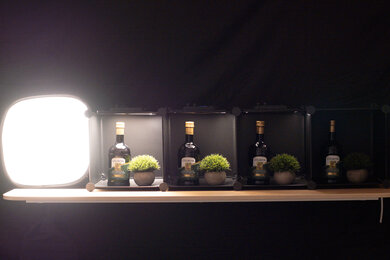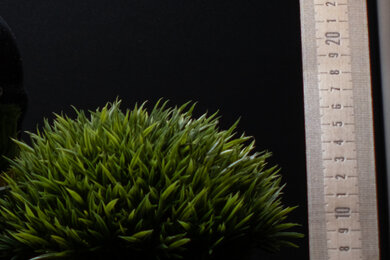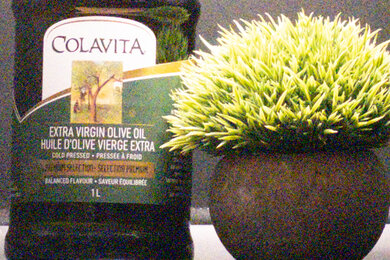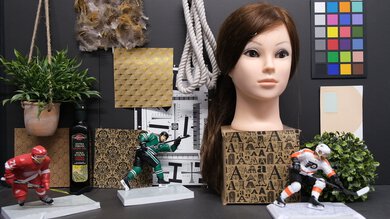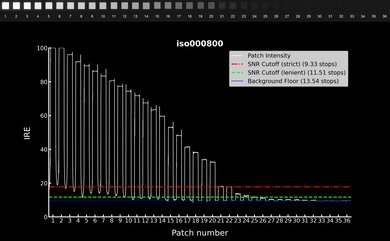The Fujifilm X-T30 II is an update of the original Fujifilm X-T30 from 2019. Like its predecessor, the X-T30 II is an interchangeable-lens mirrorless camera that sits in the mid-range of Fujifilm's APS-C lineup, representing a cheaper, more compact alternative to the Fujifilm X-T3. It's a very portable camera with more physical buttons and dials than the entry-level Fujifilm X-T200. It makes for a nice sweet spot between the more portable Fujifilm X-E4 and the more video-oriented Fujifilm X-S10.
Our Verdict
The Fujifilm X-T30 II is good for travel photography. It has a small, lightweight body that feels well-built and makes it easy to take on the go. JPEG photos look excellent straight out of the camera, with minimal noise and pleasing colors. While it has plenty of physical dials and buttons that make it easy to adjust settings on the fly, it can also feel a bit cramped due to its small size. Its battery life is also somewhat limited, although you can always buy spare batteries or charge this camera on the go with a portable power bank.
- Portable, lightweight body.
- Easy to adjust settings on the go.
- Excellent overall image quality.
- Battery life is somewhat limited.
- Ergonomics can feel cramped.
The Fujifilm X-T30 II is good for landscape photography. It has good noise handling for an APS-C sensor, and RAW files have a fair amount of exposure latitude, so you can make exposure adjustments without sacrificing too much quality. If you shoot in JPEG, images look great straight out of the camera, with several film simulation profiles to choose from to get a different look and feel. The camera also has an HDR mode, which uses in-camera processing to get an image with higher dynamic range. That said, while its compact size is convenient, it makes for more cramped ergonomics.
- Portable, lightweight body.
- Excellent overall image quality.
- Ergonomics can feel cramped.
The Fujifilm X-T30 II is decent for sports and wildlife. It has a fairly quick max burst rate for capturing faster subjects, and it has a very large photo buffer if you shoot in JPEG. However, its RAW photo buffer is much more limited, and it takes a long time to empty once full. Its autofocus system is good, but the tracking can sometimes struggle to keep up with faster-moving subjects.
- Portable, lightweight body.
- Excellent overall image quality.
- Decently fast burst rate.
- Small RAW photo buffer.
- Long buffer empty time.
- Ergonomics can feel cramped.
The Fujifilm X-T30 II is okay for vlogging. It's portable and does an excellent job smoothing out camera shake when paired with an optically stabilized Fuji lens. Video quality is also great. However, you can't flip the screen around to face you while recording, and it suffers from overheating issues when shooting for longer periods in 4k. There's also a lot of rolling shutter distortion in 4k, which can cause distracting skewed lines in the background of your videos.
- Portable, lightweight body.
- Excellent optical stabilization.
- Great video quality.
- Screen doesn't articulate or turn to face forward.
- Can overheat when recording continuously in 4k.
- Heavy rolling shutter effect in 4k.
The Fujifilm X-T30 II is decent for studio video. Video quality is great in more controlled lighting conditions, and the camera can output 10-bit 4:2:2 video over HDMI. It also supports Log recording and has excellent dynamic range in video. Internally, however, it's limited to 8-bit 4:2:0 color, somewhat limiting your flexibility to color grade. It also tends to overheat when recording for longer periods in 4k. While there's a microphone input, the camera doesn't have a headphone jack to monitor your audio while shooting.
- Portable, lightweight body.
- Great video quality.
- Supports Log recording.
- Can overheat when recording continuously in 4k.
- Heavy rolling shutter effect in 4k.
- Limited to 8-bit 4:2:0 color internally.
The Fujifilm X-T30 II isn't meant for action video, but it's okay for filming sports. The camera is lightweight and portable, though it isn't designed for mounting on a helmet or chest rig. It does an excellent job of smoothing out video footage when using an optically stabilized lens, but you still need a gimbal or stabilizer to get very smooth action footage. The camera's 4k frame rates are also limited for action video, but it does have a high-speed recording mode in 1080p.
- Portable, lightweight body.
- Excellent optical stabilization.
- High-speed recording mode for slow-mo 1080p.
- Can overheat when recording continuously in 4k.
- Heavy rolling shutter effect in 4k.
- Not water-resistant.
- Limited 4k frame rate options.
The Fujifilm X-T30 II has good RAW image quality. Images appear sharp and detailed thanks to its high-resolution sensor. It also has good dynamic range, so it can preserve a fair amount of highlight and shadow detail in high-contrast scenes. That said, its noise handling in low light is just decent, so you'll inevitably see noisier files in very tricky lighting conditions.
- High resolution.
- Good dynamic range.
- Noise handling is only decent in low light.
Performance Usages
Changelog
-
Updated Feb 10, 2025:
We wrote text for the new tests added in Test Bench 0.13 and updated the Verdict section accordingly.
- Updated Feb 03, 2025: We've converted this review to Test Bench 0.13. We've added new tests for Video Dynamic Range and Luminosity Patch Detection. You can learn more about these updates in the changelog.
- Updated Aug 20, 2024: We added comparisons to the newly reviewed Fujifilm X-T50 in the Ergonomics & Comfort, Sensor, and Video Features boxes.
- Updated Apr 17, 2024: We've added some additional information to the 'Sensor' box and brushed up some of the existing text to more closely meet our current review standards.
Check Price
Differences Between Sizes And Variants
The Fujifilm X-T30 II comes in two color variants: Black and Silver. You can purchase the body alone or bundled with the Fujinon XF 18-55mm F2.8-4 R OIS kit lens.
See here for our unit's label.
Popular Camera Comparisons
The Fujifilm X-T30 II is a fairly well-rounded entry-level camera. As is typical for Fujifilm, it has a portable design with retro flair, including physical exposure dials that make it easy to adjust settings on the fly. However, while its autofocus performance is decent for its class, it isn't as effective as competing cameras from Sony or Canon.
Physically, this camera is nearly identical to the original Fujifilm X-T30, with the biggest difference being a higher-resolution screen. On the inside, however, it has some nice improvements, including a newer AF system, a larger photo buffer, and longer video recording times. Still, if you already own the X-T30, it isn't necessarily worth the upgrade.
For more options, check out our recommendations for the best cameras for beginners, the best budget mirrorless cameras, or the best cameras for travel.
The Fujifilm X-T30 II is a refreshed version of the Fujifilm X-T30. The cameras look almost identical on the outside, though the Mark II has a higher-resolution tilting screen. The X-T30 II also has internal upgrades, including a newer autofocus system, a slightly larger photo buffer, and longer video recording time limits. Overall, it's a solid improvement, but if you already own an X-T30, it isn't different enough to warrant an upgrade.
The Fujifilm X-T50 is the successor to the Fujifilm X-T30 II. The X-T50 offers a few major updates, including an in-body image stabilization system, a higher-resolution sensor, better autofocus, better video features, and a slightly redesigned body with better ergonomics. That being said, it also sits at a significantly higher price point. So, while the X-T50 is clearly the winner here, it may not be the best-value choice for some people, especially if you don't need the advanced video capabilities it offers.
The Fujifilm X-T5 is better than the Fujifilm X-T30 II. The X-T5 sits at a higher price point, so it offers better build quality, a higher-resolution EVF, and a new higher-resolution sensor and processor. In addition, the X-T5 has an upgraded autofocus system, faster burst shooting, and better video specs.
The Fujifilm X-S20 is better overall than the Fujifilm X-T30 II. Though both cameras use the same sensor and offer similar image and video quality, the X-S20 has an updated autofocus system that's more effective at tracking moving subjects, as well as a longer battery life and better ergonomics. It also supports faster UHS-II SD cards and offers better video specs, including more 4k frame rates, internal 10-bit recording, and the option to shoot in 6.2k.
Test Results

The Fujifilm X-T30 II is quite portable, with nearly identical dimensions to the Fujifilm X-T30. The body is narrow, if a little tall, but it has a slim profile that makes it easy to carry on the go or slip into a camera bag. It also doesn't weigh much, so it won't cause much fatigue on long shooting days.
The camera feels well-built. Like the Fujifilm X-T30, it's made of metal and plastic and feels sturdy and high quality. Inputs are covered by a rubber flap, while the battery and SD card slots are covered by a hinged door.
The Fujifilm X-T30 II has three command dials, which also have press functionality to control different settings. There's a front command dial, a rear command dial, and a dedicated shutter speed dial on top.
On top of that, the camera has an exposure compensation dial and a dedicated drive mode dial, so you can easily switch from single to continuous shooting to movie mode and more. On the front of the camera, you also have a focus mode toggle to quickly switch between single autofocus, continuous autofocus, and manual focus. Many of the buttons and dials are customizable as well.
- Fujifilm X-T30 II camera body
- Fujinon XF 18-55mm F2.8-4 R OIS lens
- Front lens cap
- Rear lens cap
- Sensor cap
- Shoulder strap
- 1x NP-W126S battery
- USB-A to USB-C cable
- User manual and documentation
The Fujifilm X-T30 II has mediocre ergonomics. The small size of its hand grip and body make it feel a bit cramped to hold for those with larger hands. Because of its size, it's also easy to press buttons accidentally, particularly the 'Q' menu button because of its placement near the back thumb rest. That said, the camera feels well-balanced with the Fujinon XF 18-55mm F2.8-4 kit lens attached, and having a dedicated shutter speed dial and two command dials gives you full hands-on control over your exposure settings. The thumbstick on the back is also intuitive to use for menu navigation or AF point selection. The ergonomics are notably improved on newer models in the series, like the Fujifilm X-T50.
The screen is bright enough to overcome glare in sunnier conditions, and its tilting design is ideal for waist-level shooting. The screen also has a notably higher resolution than the original Fujifilm X-T30, giving you a sharper image and making it easier to review your photos on the monitor. The screen's touch capabilities are limited to selecting focus points, use as a touch shutter, and enabling AF tracking.
The menu system from the Fujifilm X-T30 remains unchanged, and it's easy to navigate using the thumbstick. There's a bit of a learning curve, but all submenus and settings are clearly labeled and logically organized. There's also a guide function to explain certain settings.
This camera is also compatible with Fujifilm's XApp, which Fujifilm claims to offer smoother wireless connectivity between X series cameras and smartphones than the older Fujifilm Camera Connect app. You can use it to transfer files or control the camera remotely.
Like other Fujifilm cameras of its generation, including the Fujifilm X-T4, the Fujifilm X100V, and the Fujifilm X-S10, the Fujifilm X-T30 II uses a variation of the same X-Trans 4 sensor and X-Processor 4 as its predecessor. It's a high-resolution APS-C sensor with a backside-illuminated design for more efficient light gathering and a fairly wide native ISO range. If you'd prefer a higher-resolution sensor, consider the Fujifilm X-T50 instead.
The camera's battery performance is okay. It has a 390-shot CIPA rating, which is slightly better than the original Fujifilm X-T30, rated at 380 shots. That's a fairly average CIPA rating for a mirrorless camera, though these ratings don't necessarily align with real-world usage, so your mileage will vary depending on your shooting habits and settings.
You also get about an hour of battery life in video mode when shooting continuously in 4k, which isn't great. Thankfully, it supports external power delivery via USB-C, which is handy if you have a portable battery pack.
The camera has an okay continuous shooting speed. It maxes out at 8 fps when using the mechanical shutter, which is decently fast for capturing burst shots of moving subjects and action. When using the silent electronic shutter, it can shoot at up to 10 fps, which is great for capturing sequential bursts when you need to be discreet or when taking photos of skittish wildlife, though using the e-shutter can also cause rolling shutter distortion with quicker subjects. Unfortunately, if you're shooting in RAW format, the camera's image buffer fills up very quickly. If you do fill it up, it also takes a little while to empty, which can interrupt your shooting at a critical moment. That said, you can shoot JPEG files indefinitely.
The Fujifilm X-T30 II uses a hybrid autofocus system. Unlike the Fujifilm X-T30, the Mark II uses Fuji's updated tracking system, the same one found on the Fujifilm X-T4. It's a little more intuitive, with a single tracking box that locks onto your target rather than the busier interface of the older model.
The camera supports face and eye detection, but it isn't especially reliable. It's easily confused with multiple faces in the frame, often switching the focus away from the intended target. While it isn't bad with slower subjects, it can quickly lose track of subjects that are moving more quickly or erratically.
If you don't want to rely on tracking, using a center focus point is a lot more effective. If you can keep your intended target under the focus point, the autofocus keeps up with little to no trouble.
The Fujifilm X-T30 II doesn't have in-body image stabilization. However, you can use optically stabilized lenses if you need to shoot at slower shutter speeds without a tripod. With the XF 18-55mm F2.8-4 kit lens, which has optical image stabilization (OIS), the camera does an excellent job of stabilizing handheld shots.
The Fujifilm X-T30 II has good usable dynamic range, capturing a fairly wide range of detail in high-contrast scenes. Overall, it performs well for an APS-C sensor, and RAW files have pretty good exposure latitude, allowing you to adjust your exposure by a few stops without introducing too much noise.
The camera does a great job of resolving fine detail. While this is most apparent when punching in, it means you have a bit of leeway to crop in your photos without losing too much detail.
The sensor's RAW noise handling is decent. It doesn't compare to cameras with full-frame sensors, but you can get relatively clean files at moderately high ISO settings, allowing you to shoot in dimmer lighting conditions without worrying too much about sacrificing quality.
The Fujifilm X-T30 II can record video in FHD and both UHD and DCI 4k. It also supports F-Log recording to get a wider dynamic range. However, it can only shoot in 8-bit internally, giving you less latitude to color-grade Log footage. It can, however, output 10-bit 4:2:2 video to an external recorder via HDMI if you need more flexibility with grading. For a more video-capable camera, check out the Fujifilm X-T50.
The Fujifilm X-T30 II can record 4k video at up to 30 fps, which is good for a range of video styles, but the camera lacks any high frame rate options for smooth action video or slow-motion recording in 4k.
4k internal recording capability is adequate. The camera can capture video at fairly high bit rates, resulting in higher-quality video files. However, it suffers from severe overheating issues when continuously recording in the highest quality settings. So, despite having a significantly longer 30-minute recording time limit than the ten-minute cap on the original Fujifilm X-T30, your recording time may still be limited, depending on your settings.
Autofocus performance is excellent overall when shooting 4k video. The general subject tracking does an amazing job of keeping moving subjects in focus, and the camera supports both face and eye detection. The face tracking works quite consistently, doing a great job of maintaining focus on moving faces, though it can lose track if subjects turn around or move very quickly, and it sometimes has to hunt to find its target. Overall, it's good for most situations but isn't as consistent as other AF systems like Sony's.
4k video quality is impressive, especially in more controlled lighting conditions. Footage looks sharp and detailed, with great out-of-camera colors. The camera also does a good job in low light. Shadows are preserved pretty well, and there isn't an overwhelming amount of noise.
Unfortunately, the Fujifilm X-T30 II has a slow sensor readout speed, which results in a very noticeable rolling shutter effect. With faster camera movements, vertical lines look heavily skewed.
The Fujifilm X-T30 II has a wide range of frame rate options in 1080p. In its regular video mode, it can shoot at up to 60 fps, so you can capture smooth action or slow things down slightly for cinematic-looking slow-motion. It also has a high-speed recording mode, like other Fujifilm cameras, that records slow-motion footage at up to 240 fps in 1080p, with no audio. That's an improvement over the 120 fps limit of the Fujifilm X-T30. However, this mode incurs a slight crop.
Internal recording is good in 1080p. It captures relatively high bit rates, resulting in videos with more visual information and detail. As with 4k, the recording time limit is 30 minutes, improving upon the Fujifilm X-T30's 15 minutes. You're also less likely to experience overheating in 1080p.
Autofocus is still excellent in 1080p, though, like with 4k, it can sometimes lose its target or hunt a little before finding it. Overall, it still does a great job tracking moving subjects and supports both face and eye detection.
There's less rolling shutter distortion in 1080p, but you'll still see skewing or wobbling with faster camera movements.
The Fujifilm X-T30 II has excellent dynamic range in video. It captures a very wide tonal range above the background noise floor, which is amazing. However, taking noise into account, you'll have around 11 to 12 stops of usable dynamic range at most. That's still excellent and allows you to capture more detail in high contrast and gives you more flexibility with your footage in post.
Tested settings:
- Resolution: 4k
- Frame Rate: 30 fps
- Log Format: F-Log
The Fujifilm X-T30 II has a wide array of inputs and outputs, including a USB-C port for charging, power delivery, and file transfer and a Micro HDMI port to connect to an external display. While there's a mic input, the camera doesn't have a headphone jack to monitor your audio while you record. Unlike the Fujifilm X-T4, this model doesn't come with a USB-C-to-3.5mm adapter in the box.








